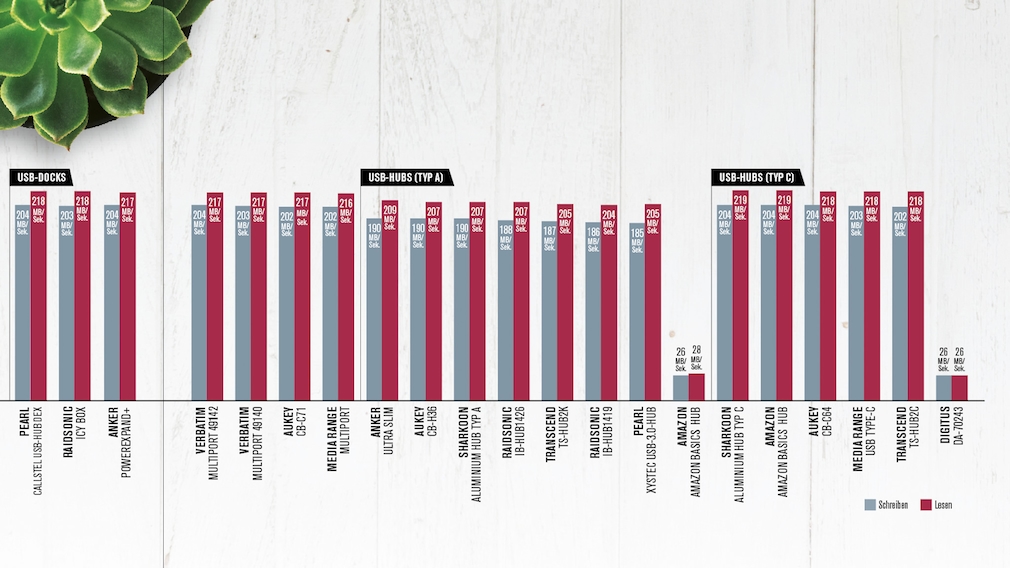If you want to be beautiful, you have to suffer: This proverb also applies to notebooks. The disadvantage of ultra-thin laptops is that there is hardly any space for extra connections. Customers have to be content with just a few USB ports. Card reader, HDMI socket, LAN connection? None! The solution is external connection docks. COMPUTER BILD tested seven models.
Test winner: Anker PowerExpand+
the Anchor PowerExpand+ is the test winner among the USB docks of type C. This is partly due to the good workmanship. The connectors wobble slightly, but the housing is made of solid aluminum. The technology doesn’t disappoint either: HDMI, LAN and a card reader – the anchor offers many functions.
Price tip: Verbatim USB-C Multiport 49140
the Verbatim USB-C Multiport is a decent type C USB dock. It is well made, the aluminum housing is stable. Only the technical possibilities are somewhat limited: HDMI and enough USB ports are available, but there is no LAN socket. But for the price, that’s tolerable.
Although USB docks are a bit more complicated than USB hubs, they can still be compared well with each other. In contrast to USB hubs, which only provide your notebook or computer with additional USB sockets, docks expand the functionality.
What are the functions of the USB dock?
An example: Thin Ultrabooks or MacBooks do not have LAN sockets and USB-A ports. Card readers are often missing. First of all, the COMPUTER BILD testers check how many extra functions the tested dock offers and how well it fulfills its duty.
A tool programmed by COMPUTER BILD measures the speed of the data transfer.
How fast are the USB ports?
All USB sockets go through several tempo tests. For this, the testers use a special PCIe dual USB card from Delock and a self-programmed tool. The program sends data of various sizes from an external SSD through the dock to the PC. We measure the time. The testers then repeat the test without the dock. The difference between the two measurements shows the throttling. The following applies here: the lower, the better.

This special PCIe card was made available to the COMPUTER BILD editorial team by Delock for speed tests.
How good is the processing?
The workmanship also plays a role in the evaluation: What housing material is used and how valuable is the hub overall? An important aspect: Are there extras like an additional power supply? Such details can ultimately decide on the test victory.
USB docking stations in the test: Anker wins
The same goes for the runner-up Verbatim USB-C Multiport 49142. HDMI, card reader, LAN socket and separate power connection: This dock is also an all-rounder. The device narrowly missed out on winning the test because the USB-C port is only intended for charging. If you can do without data transfer via this connection, you get a fast dock that shines with good workmanship.
Another Verbatim product secured the price-performance win: the USB-C multiport 49140. A card reader and the LAN socket are missing, but the device impresses with its price: Most online shops charge only 26 euros.
USB 2.0 sockets are lame
The extra sockets have to share the performance of the USB port on the notebook. This means that they transmit data in a throttled manner. Fortunately, the loss of speed of the Anchor PowerExpand+ within limits, it only lost between 10.4 and 7.83 percent in writing and reading. Also the Verbatim Docks hardly slowed down: between 10.55 and 8.15 percent. These are good results, which the device owes to the more modern, first-generation USB 3.2 sockets. Slow USB 2.0 technology is not used in the anchor dock.

USB docks are a tad faster than USB hubs, as the Tempo test showed.
USB docks in the test: the conclusion
The test shows how important the USB variants are when making a purchase. Most of the candidates in the test slowed down only slightly, but the USB 2.0 hubs slowed down drastically. Docks are ideal when other connections are required in addition to USB sockets, for example an HDMI connection for a monitor. When buying, pay attention to good workmanship, because wobbly plugs may fall out.
What is the best docking station?
The currently best USB dock tested by COMPUTER BILD is the PowerExpand+ by Anker.
What do you need a docking station for?
To expand the notebook or PC with USB ports and additional sockets. For example, with HDMI for external screens or LAN for the Internet.
How do you connect a docking station?
Either via USB-A or USB-C.
Which USB port do I need for a docking station?
USB-A or USB-C, preferably with USB 3.0 technology or higher.
